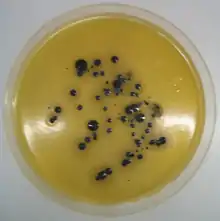Baird-Parker agar
Baird-Parker agar is a type of agar used for the selective isolation of gram-positive Staphylococci species.[1] It contains lithium chloride and tellurite to inhibit the growth of alternative microbial flora, while the included pyruvate and glycine promote the growth of Staphylococci.[1] Staphylococcus colonies show up black in colour with clear zones produced around them.[1]

History
Baird-Parker firstly publish an academic article about this agar medium for the purpose of improved diagnostic and isolating coagulase-positive Staphylococci in 1962.[2] He developed this agar medium from the tellurite-glycine formulation of Zebovitz et al[3] and improved its reliability in isolating coagulase-positive staphylococci from foods. Baird-Parker added egg yolk emulsion as a diagnostic agent and sodium pyruvate to protect damaged cells and aid their recovery.[4] It is now widely recommended by national and international bodies for the isolation of coagulase-positive staphylococci.[5] Braid-Parker agar is commonly use as a method for the enumeration of coagulase-positive staphylococci (Staphylococcus aureus and other species) in food and animal feeding stuffs.[6]
Preparation and Formulae
The following is a method for the preparation of 1 litre of Baird-Parker agar according to ISO 11133:2014 and ISO 6888-1:1999.[6]
- Measure the following. These are the base of Baird-Parker agar.
- 10 gram of pancreatic digest of casein
- 5 gram of meat extract
- 1 gram of yeast extract
- 10 gram of sodium pyruvate
- 12 gram of L-glycine
- 5 gram of lithium chloride
- 20 gram of agar
- Suspend 63g of Baird-Parker Agar (ISO) Base in 1,000ml of distilled water.
- Adust the pH into 7.2 ± 0.2 at 25°C.
- Boil to dissolve the medium and sterilise by autoclaving at 121°C for 15 minutes.
- Cool to 47°C and aseptically add 50ml of Egg Yolk Tellurite Emulsion (SR0054). Mix well and pour into sterile Petri dishes.
Dehydrated medium should be stored on 10-30°C. The prepared medium is best used freshly prepared. Dehydrated culture medium has straw coloured and free-flowing powder. Prepared medium has cream or yellow color, opaque gel.[6]
References
- "Baird-Parker Agar Base". EMD Chemicals. Archived from the original on 2008-05-01. Retrieved 2008-05-16.
- Baird-Parker, A. C. (1962). "AN IMPROVED DIAGNOSTIC AND SELECTIVE MEDIUM FOR ISOLATING COAGULASE POSITIVE STAPHYLOCOCCI". Journal of Applied Bacteriology. 25 (1): 12–19. doi:10.1111/j.1365-2672.1962.tb01113.x.
- Zebovitz, Eugene; Evans, James B.; Niven, C. F. (1955). "TELLURITE-GLYCINE AGAR: A SELECTIVE PLATING MEDIUM FOR THE QUANTITATIVE DETECTION OF COAGULASE-POSITIVE STAPHYLOCOCCI". Journal of Bacteriology. 70 (6): 686–690. doi:10.1128/jb.70.6.686-690.1955. ISSN 0021-9193.
- Baird-Parker, A. C.YR 1963. "A Classification of Micrococci and Staphylococci Based on Physiological and Biochemical Tests". Microbiology. 30 (3): 409–427. doi:10.1099/00221287-30-3-409. ISSN 1465-2080.
- CHOPIN, A.; MALCOLM, S.; JARVIS, G.; ASPERGER, H.; BECKERS, H. J.; BERTONA, A. M.; COMINAZZINI, C.; CARINI, S.; LODI, R.; HAHN, G.; HEESCHEN, W. (1985-01-01). "ICMSF Methods Studies. XV. Comparison of Four Media and Methods for Enumerating Staphylococcus aureus in Powdered Milk". Journal of Food Protection. 48 (1): 21–27. doi:10.4315/0362-028X-48.1.21. ISSN 0362-028X.
- "Dehydrated Culture Media: BAIRD-PARKER AGAR (ISO) BASE". ThermoScientific. Retrieved 8 April 2022.
{{cite web}}: CS1 maint: url-status (link)